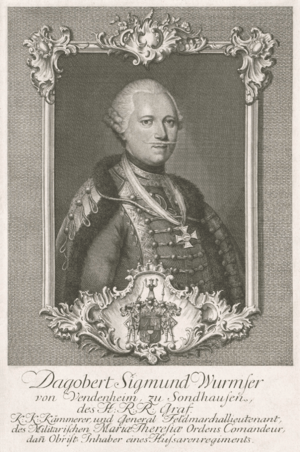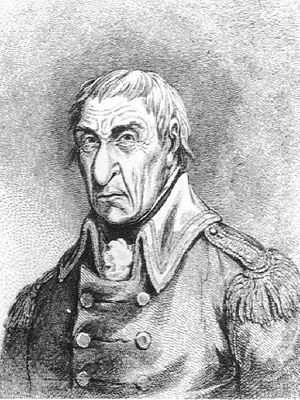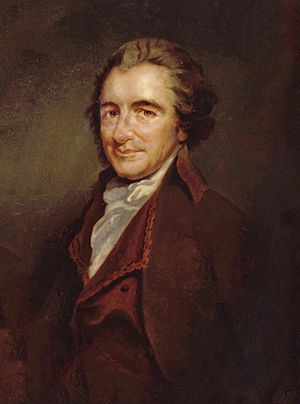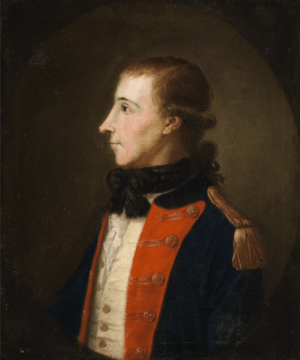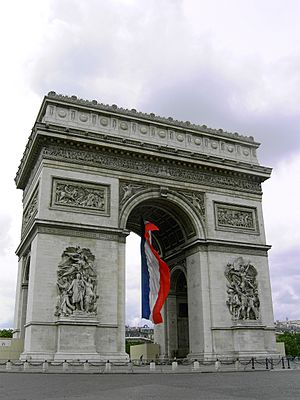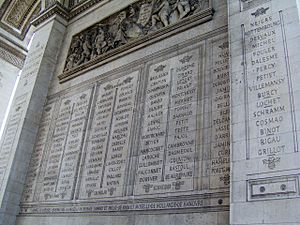Charles Edward Jennings facts for kids
Quick facts for kids
Charles Edward Jennings
|
|
|---|---|
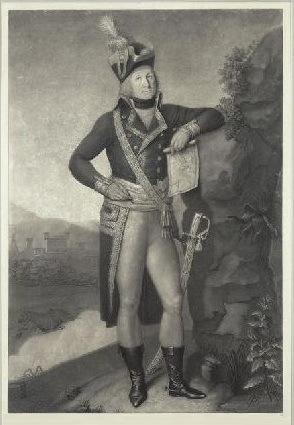 |
|
| Nickname(s) | Brave Kilmaine |
| Born | 19 October 1751 Sauls Court, Dublin, Ireland |
| Died | 11 December 1799 (aged 48) Paris, France |
| Allegiance | United Irishmen Kingdom of France First French Republic |
| Service/ |
Austrian Army French Army |
| Years of service | 1765-1799 |
| Rank | General of division |
| Battles/wars | Campagne au Sénégal American War of Independence French Revolutionary Wars |
General Charles Edward Saul Jennings (born October 19, 1751 – died December 11, 1799) was a brave Irish soldier. He served in the French army and was a strong supporter of the French Revolution. People sometimes called him Brave Kilmaine.
Jennings believed in Irish independence. He worked with Theobald Wolfe Tone, an important Irish leader. He also served as a commander under Napoleon I. Jennings fought in the American Revolutionary War and the French Revolutionary Wars. He was known for being a strong and inspiring leader. Even though he wasn't born into nobility, some people called him de Kilmaine or Baron de Kilmaine. This was a nod to his family's old home in Kilmaine, County Mayo.
Contents
Early Life and Education
Charles Edward Jennings was born in Dublin, Ireland, on October 19, 1751. His father, Dr. Theobald Jennings, was a well-known doctor. His mother, Eleanor Saul, came from a wealthy family in Dublin.
In 1738, his parents moved to Tonnay-Charente in France. But when Eleanor was expecting Charles, she returned to Dublin so he could be born in Ireland. Charles spent his early years in Dublin with his relatives. When he was 11, he moved to France to live with his father. He learned French and got his education there.
Starting a Military Career
Jennings began his military journey in 1764, at just 14 years old. He joined the Austrian army first. After serving for seven years as a young officer, he joined the French army in 1774.
In 1778, he became an adjutant in Lauzun's Legion. This was a special unit led by the Duc de Lauzun. Jennings served with this group in Senegal in 1779. He then went to America to fight in the American Revolutionary War.
Fighting for American Freedom
In 1780, Jennings became a sous-lieutenant in Lauzun's Legion. He fought alongside famous generals like Rochambeau and the Marquis de Lafayette. His time in America greatly influenced him.
He saw the ideals of freedom and independence firsthand. This, combined with his Irish background, made him believe strongly in revolutionary ideas. When he returned to France, he became a strong supporter of the French Revolution.
Rising Through the Ranks
By 1786, Jennings was promoted to Lieutenant and took charge of a Hussars regiment. Two years later, he became a Captain. His military skills were noticed, and he was promoted again to chef d'escadron.
In 1791, just before his 40th birthday, he left the army. He was given the title of Baron. He also took a special oath to become a French citizen. For nearly a year, he focused on his family. But in 1792, war broke out between France and other European countries. Lafayette personally invited Jennings to rejoin the French Army.
Jennings returned as a chef d'escadron and fought in the French Revolutionary Wars. He served under generals like Charles François Dumouriez and Lafayette. He played a key role in the Battle of Valmy in September 1792. His hussar unit saved a French division from being defeated.
In November 1792, at the Battle of Jemappes, Jennings helped turn a likely defeat into a victory. He was then promoted to Chief Colonel. People started calling him "le brillant et courageux Kilmaine" (the brilliant and courageous Kilmaine).
Leading Brigades and Divisions
Kilmaine continued to serve with the Army of the North. He was known as one of its most capable officers. After the victory at Jemappes, the army faced severe problems. Soldiers were starving, shoeless, and without proper gear. Many deserted. Kilmaine worked hard to keep order among his men. He even used his own money to help feed them.
On March 8, 1793, he was promoted to general of brigade. After General Dumouriez left the army in April 1793, Kilmaine stayed loyal to the new French government. He was rewarded with another promotion to general of division on May 15, 1793. He worked tirelessly to bring back order to the army.
Battles and Retreats
Kilmaine led the advance guard in battles against allied forces in May 1793. He showed great bravery, even having two horses shot from under him. On May 8, during the Battle of Raismes, the French were defeated. General Dampierre was killed, and Kilmaine was ordered to cover the army's retreat.
Later, Kilmaine was briefly sent to the Army of Ardennes. He was soon called back to the main army, which was in a very difficult situation. The army was small and disorganized. Its leaders, except for Kilmaine, lacked skill.
Commander of the Army of the North
On July 17, 1793, Kilmaine was named Commander-in-Chief of the Army of the North. He faced a much larger enemy force. With only 24,000 troops, Kilmaine decided not to attack. He knew that if he lost, the enemy could easily reach Paris.
In the Battle of Caesar's Camp on August 7–8, Kilmaine chose to retreat his army rather than be surrounded. Even though it was a smart move, the government saw it as a "mutiny."
Imprisonment and Freedom
Because of his retreat and suspicions about his foreign birth, Kilmaine was removed from his command. He was sent away to Luxembourg. He said he was ready to serve the Republic in any way he could.
Kilmaine secretly returned to Paris with his wife. They lived quietly for a few months. But when the Reign of Terror began, they were both arrested and put in prison. Luckily, Kilmaine avoided being executed. He and his wife were released in July 1794, after the fall of Robespierre.
Italian Campaign Success
In May 1795, Kilmaine helped stop a rebellion in Paris. He worked with Napoleon Bonaparte and the revolutionary party.
In early 1796, he joined Bonaparte in the Italian Campaign. He fought bravely at the Battle of Lodi on May 10, helping to secure the victory with a cavalry charge. In September, he became Commander of Northern Italy. His actions in this campaign made him very famous across Europe.
In October, Kilmaine was one of Napoleon's main commanders during the Siege of Mantua. He successfully stopped Austrian attempts to break out of the city. Napoleon praised Kilmaine's efforts in his reports.
Kilmaine commanded the troops during the Siege of Mantua for over five months. The Austrian general, Wurmser, finally surrendered on February 3, 1797. Kilmaine sent a dispatch to the Minister of War, announcing this important victory.
The capture of Mantua was a huge celebration in Paris. Kilmaine was honored as "the Irish Commandant of Lombardy." After this victory, he was awarded the title Baron de Kilmaine.
Plans to Invade Britain and Ireland
In 1798, France planned to invade Britain and Ireland. Kilmaine was a key part of these plans. In February, a large French army marched to the English Channel coast. This force included many famous generals.
On St. Patrick's Day, Kilmaine hosted a big dinner in Paris. Many Irish generals and rebels were there, including Napper Tandy and Thomas Paine. They toasted to an "Irish Republic" and spoke about Ireland's desire for freedom. Kilmaine strongly believed in this cause.
Soon after, Kilmaine was appointed Commander-in-Chief of the Armée dAngleterre. This army was supposedly meant to invade the British Isles. Many believed this was a trick to make Britain think the invasion was for Ireland, while Napoleon actually planned to go to Egypt. Even if it was a trick, Kilmaine didn't know it. He worked hard to prepare the large invasion force.
Kilmaine, along with other Irish and French leaders, planned an invasion of Ireland. They knew that many Irish people were ready to fight for their independence.
Kilmaine's Health and Failed Invasions
Kilmaine's health began to decline. He was constantly traveling and working to organize the invasion force. Despite his illness, he continued his duties.
The European newspapers praised Kilmaine. An officer on his staff wrote that the troops were eager to fight under "the brave and brilliant warrior Kilmaine." A Brussels newspaper said that Kilmaine, being Irish, would lead the French and Irish forces in Ireland.
However, the French government had doubts. General Hoche, a key supporter of the Irish plan, died. Napoleon's focus shifted to war in the East, and he lost interest in Ireland.
In 1798, the French government began to break up the invasion army. Kilmaine went to Paris to argue for the invasion, but his pleas were ignored.
Several smaller French attempts to land in Ireland failed:
- In August, about 1,000 French soldiers landed in County Mayo. They joined Irish rebels but were defeated at the Battle of Ballinamuck.
- A second attempt in September, with Napper Tandy, failed to land and returned to France.
- The final attempt in October, with about 3,000 men and Wolfe Tone, was intercepted by the British Navy and surrendered. Tone was captured.
The British press often joked about "Paddy Kilmaine and his gang," thinking he led these invasions. But Kilmaine never actually sailed to Ireland. He oversaw the departure of his troops from France, but he remained behind.
Broken Dreams
By the end of 1798, the plans for invading England and Ireland were completely abandoned. Napoleon's focus was now entirely on the Middle East. This decision crushed Kilmaine's hopes of helping his homeland gain independence.
Kilmaine was a close friend of Wolfe Tone. When he heard of Tone's arrest in Ireland, he strongly urged the French government to help him. He wrote a powerful letter to the government, asking them to treat Tone as a French officer and even suggesting they hold a British prisoner as a hostage for Tone's safety.
Despite his efforts and support from other French leaders, Kilmaine's appeal was ignored. Wolfe Tone was found guilty and sentenced to death.
Commander in Switzerland
In early 1799, Kilmaine's health worsened. He was also deeply saddened by the death of his friend, Wolfe Tone. That spring, the French government appointed him supreme commander of the army in Switzerland.
The 48-year-old Kilmaine accepted the command, ignoring his poor health. But his condition quickly declined, forcing him to retire from active service for good. He watched with sadness as the army he once led marched into the Swiss mountains.
Death
In a very weak state, Kilmaine left Switzerland and returned to Passy, a suburb of Paris. His personal sorrows added to his physical pain. His health was completely broken. He died of dysentery on December 11, 1799, at the age of 48.
Legacy and Honor
Charles Edward Jennings is honored at the famous Arc de Triomphe in Paris. His name is carved on the inside of the arch, on the Northern pillar, Column 05. This is a great honor for a military leader.
Captain Landrieux, who worked closely with Kilmaine, described him as "the only officer in whom Napoleon ever placed complete and utter confidence." Kilmaine was a generous man. He often used his own money to help his soldiers get food.
General Charles Tristan, Marquis de Montholon wrote about Jennings, calling him "Brave and noble Kilmaine." He praised Kilmaine's calmness, foresight, and excellent skills as a cavalry officer. He noted that Kilmaine provided important services to the army despite his delicate health.
Wolfe Tone also wrote about Kilmaine in his private journal. He mentioned that some Irish people didn't fully trust the old Irish Brigade officers. Tone noted that Kilmaine had to retreat from the "Camp de Caesar," which had left a bad impression, even if it wasn't his fault.
There is a portrait of General Kilmaine in the City Hall of Tonnay-Charente, France. A monument was built in his memory there in the 19th century. A street in Tonnay-Charente, Rue du Général Kilmaine, is also named after him.
Family
Kilmaine married when he was fairly young and had at least one child. It is believed his wife, 'Baroness de Kilmaine', died a few years before him. It is likely that many of his descendants still live in Ireland and France today.


